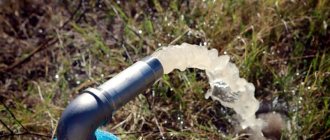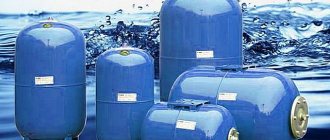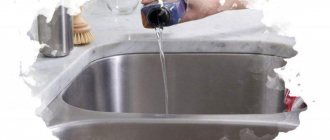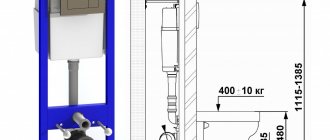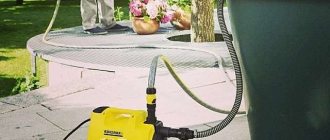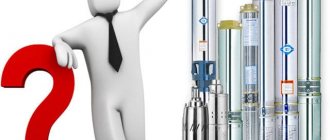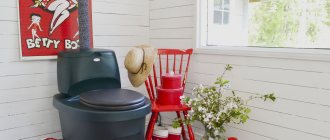Garden, vegetable garden, flower beds, lawns - everything needs regular watering. Conventional pumps for water supply do not always cope with this task - watering has its own characteristics, so a pump for watering a vegetable garden, garden, flower garden and lawn is chosen separately, using a completely different approach.
To water your garden, you need to choose the right pump.
Types of pumps
1-Surface pump 2-Submersible pump
Currently, there are a large number of different models of pumps on the market designed for watering a garden or personal plot.
According to their design features, they can be divided into two large groups, such as:
- Surface pumps . It can be placed on the site. In turn, a corresponding water suction hose is lowered into the well or barrel from this device. Thus, after watering, the pump can be removed from the site and used for completely different purposes.
- Submersible pumps . Such devices are mounted on a cable directly in the well. They may be in the water. Such devices do not always have a narrow body.
Thus, there are two main types of pumps that are used for watering the garden: surface and submersible.
Features of drainage pumps for watering the garden
Filter
Water for watering the garden does not necessarily have to be crystal clear, quite the opposite - plants “love” organic particles.
In addition, the water should not be icy - this can ruin the seedlings (watering directly from a well is harmful).
An excellent option is warm, settled water from reservoirs or collected rainwater.
If watering is carried out from a well or borehole, then it needs to be lifted into a container, allowed to warm up, and only then watered the garden.
The bottom of the drainage pump is protected by a filter, which makes it suitable for the above irrigation methods. Filters for different models can trap particles from 0.5 mm to 5 mm, but they become clogged very quickly. Therefore, they need to be cleaned periodically.
To make the filter clog more slowly, it is better not to place the pump at the very bottom of the reservoir, but to install it on a board, or hang it by the handle at least a few centimeters from the bottom.
Performance
The indicator indicates how much water the pump can pump over a certain period of time.
This value can be indicated in liters/hour, liters/minute and m3/hour.
Calculating what performance is suitable is not difficult. You need to divide the volume of the tank by the desired operating time.
Example: Pool 5 x 4 x 2m. Volume = 40 m3.
The normal time for pumping out this amount of water is about 5-7 hours.
It turns out that a pump with a capacity of 6 - 8 m3/h will cope with this task.
You should not chase high productivity if the pump is needed for irrigation. 30 - 60 l/min. (1.8 - 3.6 m3/h) is quite enough. Otherwise, the stream of water will greatly erode the soil!
Pressure
This indicator is very important for a pump that is planned to be used for irrigation. It was noticed that among users who were dissatisfied with the work of the drainage system in the garden, the pressure indicators were selected incorrectly.
Before purchasing a pump, you need to decide on two indicators:
- The depth from which the water needs to be raised.
- The distance you need to move it.
You also need to take into account the coefficient of pressure loss from pipe resistance: 1 meter of pressure will be lost for every 10 m of horizontal hose.
Well drainage pump
Example: Our pool has a depth of 2m. Plus a half-meter side. Let’s say that water needs to be diverted to the garden at a distance of 50 m.
2 m + 0.5 m = 2.5 x 50 m = 125 m. We multiply the resulting value by a factor of 0.1 = 12.5 m. That is. in the pump characteristics, the pressure must not be lower than 12.5 m!
As a rule, the higher the productivity, the lower the pressure. Since the last indicator is much more important, you need to rely on it when purchasing. After all, the main thing is that the pump copes with the tasks, albeit slower than we would like!
Nozzle diameter
Please note that sump pumps cannot be connected to regular garden hoses. The diameter of the outlet pipe of the units is at least 1 inch. It is better to immediately purchase a suitable hose of the required length.
STAVR NP-800
The STAVR NP-800 pump is a surface-type device that is designed for pumping water from tanks no more than 8 meters deep. The power of this device is 800 W. Thanks to this, the device is capable of supplying water with a capacity of up to 50 liters per minute. In order to prevent overheating of the motor, the manufacturer has provided built-in thermal protection, which in turn also affects the duration of operation.
The main advantages of the STAVR NP-800 pump are as follows:
- Compact overall dimensions
- Comfortable metal handle
- High degree of protection against moisture
- Operational safety
- Minimum noise level
Like many other devices, the STAVR NP-800 pump has certain disadvantages, such as:
- Average price range
- Inability to use for collecting water from containers of considerable depth
Thus, despite the above disadvantages, a pump of this type is in corresponding demand. Its cost fully corresponds to the technical characteristics and operational capabilities.
VORTEX PN-370
The surface pump VORTEX PN-370 is a universal device that is capable of supplying water from almost any source. The device provides liquid with good pressure over a distance of up to 30 meters. The operation of the device is distinguished by its simplicity.
The VORTEX PN-370 pump has a capacity of up to 45 liters per minute.
This device also has the following advantages:
- Significant efficiency due to the power of 370 W
- Significant resistance to external mechanical damage due to the durable cast iron body
- Engine overload protection
- Long service life of the device
- Optimal combination of cost and quality
The disadvantages of the VIKHN PN-370 pump include the following features:
- Relatively low power
- Chinese assembly
Despite the above disadvantages, the VORTEX PN-370 pump is popular. This is primarily due to low cost.
Technical part
Submersible pumps are the most popular type of irrigation equipment. The working part is immersed in water; some models can sink almost to the very bottom and completely empty the containers. Water or other liquid is supplied under pressure to the surface through long hoses. Unlike surface ones, submersible ones are able to cover a greater distance to the garden with virtually no loss of pressure. This is convenient, because the source is not always located within walking distance. Depending on the type, the outer shell of the units can be made of high-strength plastic or stainless metal. Whatever the material, it is designed for constant contact with the working environment.
The video shows how to choose a submersible pump for irrigation:
GARDENA 3500/4 Classic
The GARDENA 3500/4 Classic surface pump is distinguished by its high performance. This device is capable of pumping up to 3600 liters of water per hour. The power consumption of the device does not exceed 800 W.
Expert opinion
Kulikov Vladimir Sergeevich
The GARDENA 3500/4 Classic pump has two water outlets. As a result, it can be used to simultaneously water a very large area of the garden.
Other advantages of the model include such features as:
- Ease of use and maintenance
- The presence of a special hole with a drainage plug inside
- Reliable sealing system
- Operational safety
- Protection from mechanical external damage
- The presence of a thermal switch that is triggered in cases of overheating
Like many other models, the GARDENA 3500/4 Classic pump has a number of disadvantages, such as:
- Possibility of collecting water from containers whose depth does not exceed 7 meters
- Chinese production, despite the German brand
- Relatively high cost compared to other pumps
Due to its performance and increased functionality, this device is in demand among buyers.
Criterias of choice
Once it has become clear whether a surface or submersible pump is needed, it is necessary to study the technical characteristics of the device in more detail. When choosing, pay attention to performance, the presence of an automation system and other parameters.
Performance
The indicator is measured in liters that the pump delivers in 1 minute, hour or day. It must be calculated specifically for your case based on the fact that for normal watering of 1 m2 of garden, 4-6 liters of water per day are required.
Therefore, for each hundred square meters (100 m2) you will need 6 * 100 = 600 liters per day. For example, for a standard vegetable garden of 6 acres you need 6*600 = 3600 liters per day, i.e. 150 l per hour.
Almost all devices have this performance:
- Barrel pumps pump an average of 2000 liters per hour.
- Well 3000-4000 l per hour.
- Drainage – 5000-15000 l per hour.
Expert opinion
Samoilov Vladimir Alekseevich
Experienced gardener and specialist in gardening equipment
Ask a Question
When using a pump that supplies water from a contaminated source (pond, river), you need to choose devices with the highest productivity of 20,000-25,000 liters per hour.
Jet pressure
This is an equally important parameter that determines the distance between the source of water intake and the garden itself. For example, if the well is located at a distance of 30 m, it is better to choose a pump with a pressure of 40 m (with a margin) - then the water will flow under normal pressure.
However, too much pressure will also interfere with watering seedlings, greenery, flowers, etc. Therefore, it is better to purchase devices with the ability to adjust the pressure, since it is quite difficult to accurately calculate it for each case.
Automation system
The presence of such a system significantly increases the cost of the model. However, automation provides engine protection, which guarantees the longevity of the device. Automation determines the water level to eliminate the possibility of dry running, i.e. the pump is running idle. In addition, it will warn about sand getting into the pump (when the well becomes shallow).
Expert opinion
Samoilov Vladimir Alekseevich
Experienced gardener and specialist in gardening equipment
Ask a Question
The float switch that detects the presence/absence of liquid must be thoroughly washed once a season to prevent it from sticking to the nozzle.
Automation also allows you to organize many hours of watering of large areas. Such devices are equipped with a special timer, which you can set yourself depending on the water supply mode. Thanks to the automatic system, there is no need to monitor the duration and volume of watering.
Does your dacha have a submersible or surface pump?
SubmersibleSurface
Suction valve location
The valve providing liquid suction can be located:
- At the top.
- In the lower part (bottom of the body).
The first models are more practical because, thanks to the upper location, the risk of silt, sand and other particles entering is reduced. Therefore, when using pumps with a valve at the bottom, it is necessary to use stands that will partially protect the chamber from impurities.
Brand
The longevity of the pump also depends on the manufacturer’s brand.
Today, both foreign and domestic companies are represented on the equipment market:
- “ Hammer ” is a German brand that produces pumping equipment, including for watering the garden. It features a large and high-quality model range.
- “ Patriot ” is an American brand whose brand produces pumps, as well as good quality chainsaws.
- Calpeda an Italian manufacturer of high-precision, reliable equipment.
- " Vikhr " is one of the leading domestic manufacturers of pumping equipment.
- " Sadovod " is a Russian company that produces fairly high-quality devices at an affordable price.
- “ Gileks ” is a domestic brand, under whose brand they produce pumps for supplying clean or slightly contaminated water.
Metabo P 3300 G
Another popular surface pump for watering a garden is the Metabo P 3300 G model. The device has two water sprayers, which is convenient for a very large garden plot. The device is capable of lifting liquid to a height of up to 45 meters. This is due, among other things, to its significant power – up to 900 W.
The throughput capacity of the Metabo P 3300 G pump is also significant - up to 3300 liters per hour.
Also, the advantages of the mono device include such features as:
- The body is protected due to the fact that it is made of cast iron and steel
- Long service life
- Using a high quality O-ring system
- The capacitor motor is reliably protected from overheating
- Rubber feet for comfortable operation of the device
- Minimum noise and vibration levels
This model does not have any significant disadvantages. Some users pay attention to the relatively large mass, which is not a significant disadvantage. That is why this year this device will be quite popular among all surface-type devices intended for watering the garden.
Peculiarities
There are two types of devices used to draw water from a well.
Superficial
These devices are located at a close distance from the well and pump water using a special hose thrown into it. They are easy to install: install the unit near the source and connect the necessary hoses. The main thing is that its location is dry and protected from moisture. The photo shows a surface pump for irrigation:
The ideal option is to build a small shelter with a roof. It is necessary to provide a rubber mat on the substrate where the device will stand. It will soften the vibration of the device and reduce the noise when the pump operates. It can also be installed on the water surface of the well itself. This is possible thanks to the float, which is created to keep the pump close to the water.
How to use a robotic pool vacuum cleaner?
Here you can see photos of outdoor barbecue ovens.
The video shows how a sprinkler works for watering a garden: .
Depending on the suction principle, surface pumping devices are divided into the following types:
- inkjet
- centrifugal (self-priming)
- lobed
The first ones work even with an empty hose. They pump water from a depth of no more than seven meters. They are widely used among summer residents due to their cost and functionality.
The video shows a surface pump for watering a garden from a well:
Centrifugal water pumps for irrigation are filled with water through a specially provided hole with a plug before starting. They are single-stage and multi-stage. The more stages, the higher the performance and pressure of the pump.
The action of vane multistage pumps is carried out according to the dynamic principle. It provides strong operating pressure with low power consumption. The design of such pumps is supplemented with ejectors that increase the depth of water extraction. Their operation is accompanied by noise, so installing them near residential premises is undesirable.
Surface pumps are available in horizontal and vertical types. For home use, the former are mainly used.
Important! Vertical devices are characterized by strong pressure at high pressure, but if desired, you can find installations of this type for private water supply.
Positive aspects of using a surface pump:
- affordable price;
- compactness;
- easy installation;
- high performance. Thanks to it, you can water a large area;
- ease of operation and maintenance;
- in the presence of an asynchronous electric motor, withstands long continuous operation;
- without an ejector it works silently, so it can be installed directly in the house;
- economical, consumes less electricity than other types of pumps;
- universal;
- reliable.
Submersible
Its installation cannot be done independently; this requires professional skills. Therefore, purchasing such a pump only for irrigation does not make sense. It must be used comprehensively to provide liquid at all points of water consumption.
The submersible pump can be placed in wells with a diameter exceeding 150 mm. It is made of high-strength materials that ensure tightness and uninterrupted operation of the device when immersed in water. The main thing is to maintain a distance from the bottom of the well of at least 1 meter. If it is placed lower, the likelihood of sand or silt getting into the pumping hose will increase. Read more about submersible irrigation pumps here.
The video shows a submersible pump for irrigation from a well:
Submersible pump models are suspended from a cable attached to the eyes of the well cover. The latter must be durable and resistant to corrosion. You should choose cables with a protective coating. To connect the pump to the outlet pipeline, polymer pipes are used, which are durable and safe. Some submersible pump models come with special connections. They are notable for the fact that they come complete with a floating filter. Water is drawn through it, and it, in turn, protects the device from the ingress of various solid inclusions and impurities. This design is most suitable for wells with water containing sand grains.
There are four types of submersible pumps:
- centrifugal;
- vortex;
- screw;
- vibration.
The first two types are suitable for home use.
In centrifugal pumps, water is supplied by rotating the impeller. Due to the accumulation of various types of waste residues on rotating parts, the pump has to be repaired over time. But not a single device operating in an aggressive environment is immune from this. This is compensated by their high performance and ability to work even with contaminated liquids.
Vibrating models are more demanding; they can fail if sand particles or silt enter. They do not have rotating parts, and water is supplied through a flexible membrane that moves in the desired direction. When moving in one direction, water is sucked into the pump, and when it bends in the other direction, it pushes water into the pipe, thereby bringing it to the surface. Such pumps are characterized by strong vibration, but it is not harmful to the thick walls of the well. They have a low cost compared to centrifugal models.
Advantages of submersible pumps:
- even at low power they can provide good pressure;
- They do not need to be filled with water before use, as is the case with surface devices. Because the pumps are completely immersed in liquid and water is already present inside them. Therefore, it is enough to simply turn on the pump, without preliminary preparation;
- quiet operation;
- protection against overheating due to the fact that all parts and components of the device are located in water;
- they are made of durable materials with anti-corrosion protection;
- all pumps are equipped with filters that prevent large contaminants from entering the device;
- a built-in float-type protection system automatically stops the pump if the water level drops below the required level;
- versatility of units;
- their design uses non-metallic bearings, which have high wear-resistant properties and significantly extend the service life of the entire device;
- capable of lifting water from 30 meters depth;
- low and medium performance models have an affordable price.
Important! Submersible pumps should only be installed and maintained by professionals. This also applies to removing it for storage in the winter, which requires special conditions.
Technopribor Rucheek-1
One of the popular submersible pumps designed for watering vegetable gardens is Technopribor Rucheek-1. This product is manufactured by a Russian company and is sold at a very low cost. The pressure of this device reaches 60 meters.
The productivity of Technoprobor Rucheek-1 is very low. It reaches 1050 liters per hour. The power of this model is appropriate - only 250 W.
The advantages of the device include such features as:
- Significant cable length (15, 25 or 40 meters)
- Affordable price not exceeding 1500 rubles
- Possibility to leave the device on the surface of the water without lowering it to the bottom
The disadvantages of Technopribor Rucheek-1 are:
- Low performance and power
- Can only be used with clean water
- Low reliability and build quality
- Minor functionality
Thus, Technopribor Rucheek-1 is a submersible pump that can be useful only in cases of infrequent use in relatively small gardens.
Factors determining the choice of pump type
There are many types of pumps for watering summer cottages. True, they were not created specifically for summer residents, but they have one thing in common - working with water. But the selection of the device depends on what kind of water you are going to pump and where you will get it from. For plants, water does not have to be perfectly clean and transparent. They require warm, preferably settled water without harmful impurities and chemical waste from production. The ideal option is rainwater, which the owners accumulate in different containers throughout the site.
More often, water is taken directly from a well or borehole. But its temperature is quite cold, and if you constantly water the plants with such water, then the root system of many crops will begin to rot (for example, cucumbers). To warm up well water, summer residents raise it to the surface and let it warm up in some containers for several hours. And then they scoop it up with buckets and water it. Residents whose dachas are located next to natural reservoirs also collect water using the same system. They put it in barrels, let it sit for a couple of hours and then start watering.
If the landscape of the site includes artificial reservoirs (a pond or a home pool), then you can use water to water them. It will be warm and settled, but in this case the pool cannot be cleaned with chemicals, otherwise all the “chemistry” will end up on your table with the vegetables. This watering option provides a double benefit: you will periodically refresh the liquid in the reservoir and find where to put the old one.
The water in all of these sources differs in the degree of contamination. And when choosing garden pumps for irrigation, be sure to take into account the place from which the water will be drawn. For each source, separate types of surface, submersible, drainage and other units have been developed.
BISON NPG-M1-400
This submersible pump is distinguished by the fact that it can also work with contaminated water. As a result, the device has gained much more popularity than the previous model. This unit has too little pressure - only 5 meters. At the same time, its productivity is very significant - up to 7500 liters per hour.
The ZUBR NPG-M1-400 submersible pump is assembled in China.
It is distinguished by such advantages as:
- Reasonable price
- The presence of a float for controlling the immersion level
- Reliable protection system
- High build quality
Experts include the following main disadvantages of the pump:
- Low pressure
- Difficult to repair
Despite the fact that this model is assembled in China, it competes well with many analogues.
Automatic for drip irrigation
A separate group includes automatic pumps that provide uniform drip irrigation. They are equipped with a timer that allows you to set the spraying time. Such pumps are equipped with additional elements - a hydraulic accumulator and a pressure switch. Because of this, the cost of the models increases, but using such pumps is especially comfortable. In addition, automation saves time.
Hammer NAP 900A
A distinctive feature of this submersible pump is its significant performance. In one hour, up to 14,500 liters of water can pass through the system of this device. As a result, with the help of this device it is possible to water large vegetable gardens, orchards or personal plots.
Expert opinion
Kulikov Vladimir Sergeevich
The Hammer NAP 900A centrifugal pump can work without problems, including with dirty water. That is why buyers often use it to collect water from various bodies of water, such as small lakes, stakes and rivers. In addition, it can be used to collect water from barrels.
The liquid lifting height of the Hammer NAP 900A pump is only 8.5 meters.
The main advantages of the model are as follows:
- Significant level of build quality
- Very high performance
- Possibility of collecting dirty water
- Reliable 900 W motor
- Availability of a float for automatic level control
- Protection system blocking system operation
- Durability of use
- Attractive appearance
Experts consider the main disadvantages of the Hammer NAP 900A model to include such features as:
- Not very high pressure
- The need to take into account the height difference between the garden and the water source
Despite its shortcomings, the Hammer NAP 900A model fully corresponds to its price in terms of its technical characteristics and operational capabilities.
Reservoirs + wells = surface pump
Surface pumps are used to collect water from shallow wells or reservoirs (clean rivers, swimming pools). Their power is designed to lift liquid from shallow depths (not exceeding 10 meters). These pumps operate on the surface (hence the name). The device itself is installed on the ground, and a hose is lowered into the reservoir. For such purposes, you cannot use rubber hoses, because during the pumping process, rarefied air is formed inside the walls, and the hose contracts, blocking the passage of water.
To connect the pump, you need to place it on a solid base and connect the hoses. But be prepared that the system will make a lot of noise during operation. You can suppress the noise level with a rubber mat, but if you don’t have one, then hide the unit in some shed.
The advantage of surface pumps that take water from a pond or well is that you don’t have to move around much to irrigate. Thanks to the powerful jet, you can irrigate approximately 40-50 meters while standing in one place.
When watering, you need to install surface pumps on a solid base, and to make it less noisy, place a rubber mat
Many summer residents are wondering whether it is possible to install such a pump on the site and run long hoses to the source of water intake (i.e., a river), because some systems are quite heavy, and not everyone can carry them back and forth, and they can even be stolen, until you get there. Definitely not possible. The maximum distance to water is 9 meters (including hose immersion). Such devices are not designed for more.
Of the two types (vortex and centrifugal), the first is created only for clean water, which means it cannot be used in reservoirs. The second one is not so sensitive to impurities, and if it is equipped with an additional filter, it can also be pumped from a shallow river. The efficiency of a vortex one does not exceed 50%, but with characteristics similar to those of a centrifugal one, it will create 5 times more pressure, which plays a decisive role in some types of irrigation (for example, sprinkling).
Among the obvious advantages of surface pumps, it should be noted their ability to operate normally with frequent starts, i.e. You can turn the watering gun off and on without fear that the motor will burn out.
KARCHER BP 1 Barrel
The KARCHER BP 1 Barrel barrel pump is distinguished by its Chinese production, despite the fact that it is produced under a German brand. Despite the country of manufacture, the product is of very high quality and reliable.
The power of the KARCHER BP 1 Barrel pump is only 400 W. This is an average for such models. The device has a float to control the level. The protection system also allows you to turn off the device if necessary. It works automatically. The KARCHER BP 1 Barrel pump has a special clamp. With its help you can attach the model to the barrel.
The main advantages of the device are as follows:
- Easy to use
- Reliability of use
- Protection system that turns off the device if there is no water at the inlet
The disadvantages of the device include such disadvantages as:
- Comparatively high cost
- Average power
- Inability to immerse in water
This year, experts expect that this model will have corresponding demand among summer residents and gardeners.
Review of more expensive models
Models from a higher price segment are more productive; they are often equipped with automation and deliver greater pressure.
HAMMER NAC1000A
A powerful (4600 l per hour) pump that pumps clean and contaminated water at a depth of up to 8 m. The device is reliable and durable - 5-year warranty. Sold at a price of 7,200 rubles. Users emphasize the versatility of the pump - it can be used both in a well and in a pond.
PATRIOT FQ500 N
High-performance (up to 8000 l per hour) submersible pump, which can be used to pump out clean and dirty water. The body is durable, made of cast iron, weight 10.5 kg. Sold at a price of 6,500 rubles. Gardeners note the device’s reliability and high power. Well suited for large summer cottages.
GILEX Water cannon PROF 55/75
Submersible well pump that lifts water to 75 m (capacity up to 3300 l per hour). Designed for clean water only, installed vertically. Sold at a price of 12,200 rubles. In reviews, users note the long cable length, low noise level, good water pressure, which really corresponds to the declared parameter.
Metabo P 3300 G
High-performance surface pump (up to 3300 l/h). It delivers a very good pressure – 45 m. Suitable for irrigation only with clean water, in lakes, ponds, etc. does not apply. Sold at a price of 5,500 rubles. Summer residents have noted excellent work for many years (3-4 years without complaints). The mechanism works quite quietly, the case is reliable.
KARCHER BP 1 Barrel
Submersible well pump (maximum depth 7 m). It has high productivity (up to 3800 l/hour, head 11 m). Sold at a price of 5,400 rubles. Users note the light weight (3 kg) and reliability of the design. No particular shortcomings were noticed in this model.
Hammer NAP 900A
Powerful pump (14,000 l/h), creating a pressure of up to 8.5 m. Can be used in wells up to 7 m deep. Pumps both clean and dirty water. The cost is 4000 rubles, which is one of the best price/quality ratios on the market. In reviews, users note the high-quality assembly, reliability of the case and silent operation.
STAVR NPD-400SH
This model has quite high performance. It is about 3000 liters per hour. The STAVR NPD-400Sh pump is distinguished by its affordable price, which is optimal for most summer residents. This is due to the fact that this device is assembled in China under a Russian brand.
The manufacturer has equipped its product with a float for automatic shutdown if necessary. This increases the service life of this pump.
The main advantages of the STAVR NPD-400Sh model are as follows:
- Relatively good build quality
- Affordable cost
- The presence of a pipe outlet for collecting water from the barrel
- Possibility of immersion in the tank to a depth of 5 meters
- Can be used for pumping contaminated liquids
Buyers of the STAVR NPD-400Sh drum pump noticed some of its disadvantages. They are as follows:
- Not very high power of the device
- No second water spray
- Difficulty in transporting around the garden
Thus, due to its significant productivity, this barrel pump model is in demand among gardeners and summer residents.
Water source
By and large, there are two types of pumps. But there are also modifications designed to work in certain conditions. One of these conditions is the type of water source, which is taken from a drilled well, well, natural reservoirs, storage tanks, settling tanks, and central water pipelines.
Preference is given to ponds and various containers in which rainwater can be stored. After all, for watering plants it is better to use settled liquid that is not very cold.
Water intake from an artificial reservoir
Gardeners, even if there are wells on the site, do not take water from there for direct irrigation. It is first poured into containers, allowed to settle, and only then put into use.
If a pond is dug on the property, the owners are very lucky. You just need to throw the pump in there.
Water for irrigation is taken from a well
